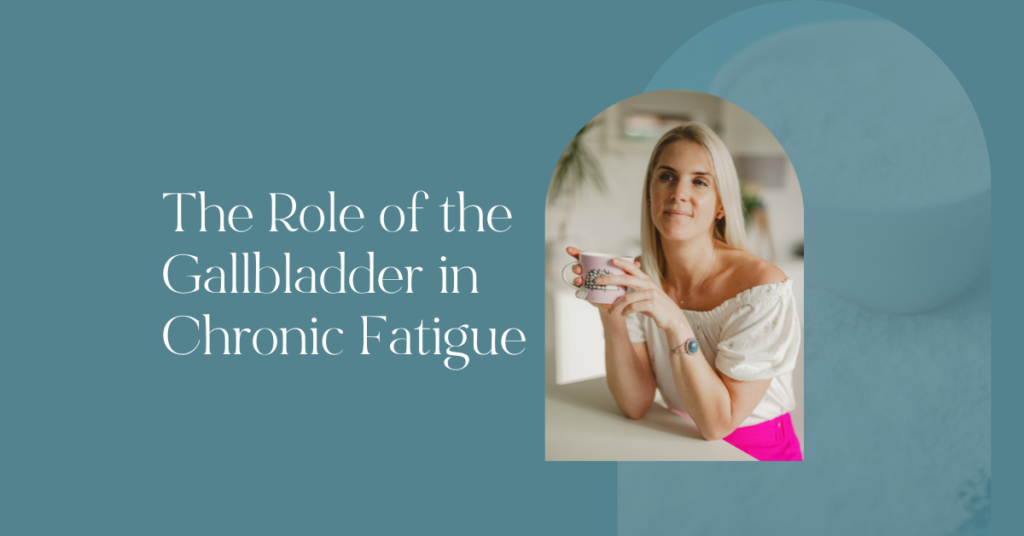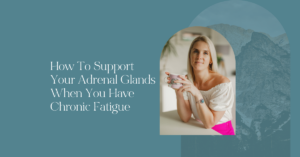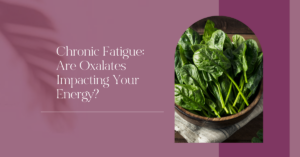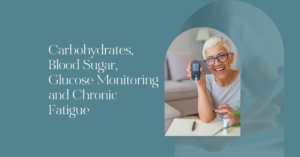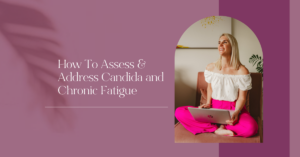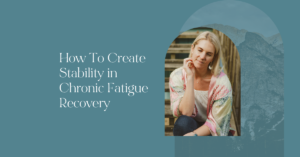Gallbladder Dysfunction can be a possible contributing factor to the presentation of Chronic Fatigue. Chronic Fatigue is the consequence of poor energy availability, due to poor production of adenosine triphosphate (ATP), which happens in the mitochondria, the “energy factory” of the cell.
There are multiple mechanisms by which the production of ATP can be impacted, and often in the case of Chronic Fatigue Syndrome (CFS), there isn’t just one mechanism, but several, all creating the same end result. The gallbladder plays a crucial role in the digestive system and overall metabolic function and therefore could be one of those mechanisms in some, but not necessarily all cases.
Read further to understand what the gallbladder is, the importance of its function and how imbalance or dysfunction may be a contributing factor in Chronic Fatigue and most importantly, how to support it.
What Is The Gallbladder and What Does It Do?
The gallbladder is a small, pear-shaped organ located beneath the liver in the upper right side of the abdomen. It is part of the digestive system and plays a crucial role in the storage and concentration of bile, a digestive fluid produced by the liver.
The gallbladder plays an important role in the digestive system. Its main function is to store and concentrate bile, a digestive fluid produced by the liver which is involved in the digestion and absorption of fats. However, healthy gallbladder function may also be important for additional functions such as maintaining a healthy balance of bacteria in the gut, regulating the gut immune system and supporting the clearance of toxins from the body.
Here is an overview of the role of the gallbladder in the digestive process:
Bile Production
The liver continuously produces bile, a yellow-green fluid composed of water, electrolytes, bile acids, cholesterol, and bilirubin.Bile acids specifically are essential for the digestion and absorption of fats.
Storage and Concentration
Instead of releasing bile directly into the small intestine, the liver secretes it into the gallbladder for storage. The gallbladder concentrates the bile by removing the water and electrolytes, making it more potent and effective in breaking down fats.
Release of Bile
When we consume a meal containing fats, the gallbladder contracts and releases the concentrated bile into the small intestine through the common bile duct. This process is triggered by the hormone cholecystokinin (CCK), which is released in response to the presence of fatty acids and amino acids in the small intestine.
Emulsification of Fats
Bile plays a crucial role in emulsifying fats, breaking them down into smaller droplets. This process increases the surface area of fats, making it easier for digestive enzymes to work on them. Emulsification is essential for the action of pancreatic lipase, an enzyme that breaks down fats into fatty acids and glycerol for absorption.
Nutrient Absorption
Emulsified fats and fat-soluble vitamins (A, D, E, and K) are absorbed in the small intestine. Bile aids in the absorption of these nutrients by facilitating their incorporation into micelles, which are small clusters that can be absorbed through the intestinal lining.
Overall Digestive Efficiency
The gallbladder’s role in releasing bile at the right time ensures efficient digestion and absorption of fats from the diet. Proper fat digestion is crucial for obtaining energy and essential nutrients from the diet.
In summary, the gallbladder’s primary function is to store and concentrate bile, which is essential for the digestion and absorption of fats in the small intestine. This process is critical for overall digestive efficiency and the absorption of fat-soluble nutrients.
Common Issues Affecting The Gallbladder
Several common issues can affect the gallbladder, ranging from mild to severe conditions. Here are some of the most prevalent gallbladder problems:
Gallstones (Cholelithiasis)
Gallstones are solid particles that form in the gallbladder. They can vary in size and may consist of cholesterol, bile salts, and bilirubin. Gallstones can block the normal flow of bile, leading to pain, inflammation, and other complications.
Cholecystitis
Cholecystitis is inflammation of the gallbladder, often caused by the presence of gallstones that obstruct the bile ducts.It can lead to symptoms such as severe abdominal pain, nausea, vomiting, and fever.
Biliary Colic
Biliary colic is characterised by sudden and intense pain in the upper abdomen, typically caused by the temporary obstruction of the bile ducts by gallstones. The pain may subside when the gallstone passes or is dislodged.
Choledocholithiasis
This condition occurs when gallstones move from the gallbladder into the common bile duct, causing blockage. Choledocholithiasis can lead to complications such as jaundice, pancreatitis, and infection.
Dysfunctional Gallbladder (Biliary Dyskinesia)
Some individuals may experience gallbladder dysfunction without the presence of gallstones. The gallbladder may not contract properly, affecting its ability to release bile. This condition can cause abdominal pain and discomfort.
Gallbladder Polyps
Gallbladder polyps are abnormal growths on the inner lining of the gallbladder. Most polyps are non-cancerous, but some may become cancerous over time. Polyps may be asymptomatic or cause pain and discomfort.
Gallbladder Sludge
Gallbladder sludge consists of a mixture of particles, including cholesterol crystals and calcium salts, which can accumulate in the gallbladder. It may predispose individuals to the formation of gallstones and other gallbladder issues. Gallbladder sludge is the consequence of not releasing bile salts adequately and it can be a cause of dysbiosis.
Gallbladder Cancer
Although relatively rare, gallbladder cancer can occur. It is often diagnosed at an advanced stage due to a lack of early symptoms. Risk factors for gallbladder cancer include age, gender, gallstones, and certain medical conditions.
It’s important to note that symptoms of gallbladder issues can overlap with other digestive or abdominal conditions. Persistent or severe symptoms should be evaluated by a healthcare professional for an accurate diagnosis and appropriate management. Treatment options may include lifestyle changes, medications, or, in severe cases, surgical intervention such as gallbladder removal (cholecystectomy).
Risk Factors For Gallbladder Dysfunction
In my early days as a practitioner, the 3 “F’s” were often used in reference to risk of gallstones and gallbladder issues. These “F’s” were:
- Female
- Overweight (Fat)
- Forty+
But the reality is that there are many more risk factors for gallbladder dysfunction that these three “F’s” alone. Additional risk factors include:
- Rapid weight loss
- Being Sedentary
- Pregnancy
- High Fat Diet
- High Cholesterol diet
- Low Fibre Diet
- Family History of Gallstones
- Diabetes (as Insulin Promotes Gallstone Formation)
- Taking certain medications, specifically oestrogen related therapies
- Mexican American
- Native American
- Poor Tolerance Of The Ketogenic Diet
Oestrogen and The Gallbladder
There is a well-established link between oestrogen and gallbladder function. Oestrogen can influence the composition of bile, impact the gallbladder’s contractility, and contribute to the formation of gallstones. This is one of the reasons why hormone replacement therapy, oestrogen specifically, and the oral contraceptive pill increase risk of gallbladder dysfunction.
Women who experience high levels of oestrogen, often referred to as oestrogen dominance, may be at risk for gallbladder dysfunction. Oestrogen dominance doesn’t always mean high total levels of oestrogen, it can be high levels relative to the amount of progesterone being produced, even when oestrogen is in a normal range or even low. Those with higher total levels of oestrogen with normal or low progesterone may be at greatest risk.
Symptoms to look out for include, but are not limited to:
- Pear shape: high body fat on hips, thighs and backs of the arms relative to the stomach
- Heavy and/or painful periods
- Breast tenderness
- Cyclical mood swings
- Fatigue
- Sleep difficulties
- Uterine Fibroids or Endometriosis
- Acne or skin sensitivity
Because the gallbladder is also important for binding toxins transformed by the liver and carrying them out of the gut in the stool (phase 3 detoxification), this can creates a vicious cycle where oestrogen dominance impacts gallbladder dysfunction and gallbladder dysfunction may enhance oestrogen dominance because there is poor clearance of oestrogen from the body.
You can read more here about how to support oestrogen dominance, in addition to supporting the gallbladder (see below). Always consult your doctor should you have any concerning symptoms relating to gallbladder dysfunction.
How Do You Know If You Have Gallbladder Dysfunction
There are many signs and symptoms of possible gallbladder dysfunction, these include:
- Bloating and distention
- Burping after fatty meals
- Upper back and abdominal pain
- Chronic digestive complaints
- Symptoms get worse when eating fatty or greasy foods
- “Fish Oil Burps”
- Nausea and Vomiting in some cases
- Diarrhoea
- Pale coloured stools
- Yellowing of the skin and eyes (jaundice)
- Dark Urine
- Unexplained weight loss
- Fatigue
- Shoulder pain on the right hand side.
Blood testing will often not show up with abnormal results unless the case is extreme. Therefore, the best way to know if there is sludge or stones in the gallbladder is to have a gallbladder ultrasound. Early sludge may not be detected on an ultrasound but there can still be symptoms of poor fat tolerance, some of which are described above.
How is the Gallbladder Connected with Chronic Fatigue?
Chronic Fatigue is the consequence of poor energy availability, due to poor production of adenosine triphosphate (ATP), which happens in the mitochondria, the “energy factory” of the cell. There are multiple mechanisms by which the production of ATP can be impacted, and often in the case of Chronic Fatigue Syndrome (CFS), there isn’t just one mechanism, but several, all creating the same end result.
The gallbladder plays a crucial role in the digestive system and overall metabolic function and therefore could be one of those mechanisms in some, but not necessarily all cases. Here are some ways in which a poorly functioning gallbladder may impact energy.
Nutrient Digestion and Absorption
The gallbladder is essential for the absorption of fat-soluble vitamins (A, D, E, and K) and fatty acids. Adequate absorption of these nutrients is crucial for overall health, including bone health, immune function, and the maintenance of cellular structures.
Proper gallbladder function ensures efficient digestion of dietary fats. Emulsification of fats by bile allows digestive enzymes to break them down into absorbable components. Efficient digestion supports the body’s energy production and nutrient utilisation.
Signs of poor nutrient absorption may include:
- Low Cholesterol Levels
- Vitamin D is low despite supplementation
- Low Platelet Count platelets
- Inability to maintain a healthy body weight
Digestive Health
Gallbladder issues, such as the presence of gallstones or inflammation, can affect the normal flow of bile, leading to digestive problems. Disruptions in the digestive process may contribute to issues such as indigestion, bloating and discomfort, all of which may contribute to systemic inflammation which drains the body’s energy.
Bile released by the gallbladder influences the composition of the gut microbiota, the community of microorganisms in the digestive tract. An imbalance in gut microbiota has been linked to various health issues, including inflammatory conditions and metabolic disorders.
Bile salts may bind to receptors in the gut and regulate intestinal inflammation.
Detoxification
The gallbladder works in conjunction with the liver, which produces bile. Both organs play vital roles in detoxification and metabolism. A healthy gallbladder supports optimal liver function, contributing to the body’s ability to eliminate toxins and process nutrients. Toxic overload in the form of chemicals, bacterial endotoxins, mycotoxins and even our own hormones (see oestrogen dominance) must be cleared from the body. A back up in toxic load can be a contributing factor to low energy.
Metabolic Health
Some research suggests a potential link between gallbladder dysfunction and insulin resistance. Insulin resistance is associated with various metabolic issues, including an increased risk of type 2 diabetes. Maintaining gallbladder health may contribute to better insulin sensitivity and poor gallbladder health could be a factor in blood sugar imbalances which influence energy levels throughout the day, especially energy levels after eating.
The Gallbladder and Chronic Digestive Complaints
Many people with Chronic Fatigue experience, often debilitating digestive complaints. In our practice we often see people with Small Intestinal Bacterial Overgrowth (SIBO) or chronic “leaky gut”, which is very difficult to manage and an ongoing source of fatigue and poor health.
Often in this case, the role of the gallbladder has been overlooked. Bile salts are involved in regulating inflammation and the balance of bacteria in the gut and therefore, the solution is not in addressing the bacterial balance or intestinal permeability directly, but rather working higher up the chain first and foremost to have a positive influence further down.
What Can You Do If Gallbladder Dysfunction Is Driving Your Chronic Fatigue?
Gallbladder Dysfunction is conventionally treated by surgery to remove the gallbladder. However, even when the gallbladder has been removed there may still be a need for bile salts, which are important to support fat digestion for energy and fat soluble nutrients, because the body has no way to store them. Although surgery may be the necessary endpoint for some, it can be helpful to understand underlying mechanisms of gallstone formation, if these can be successfully addressed, surgery may be avoided.
The goal is to optimise gallbladder contractility, motility and ejection of bile. Impaired synthesis of bile salts can lead to bile sludge and gallstones and poor gallbladder contractility means that bile salts are not ejected into the gut which not only impacts fat digestion and absorption of important nutrients, but the balance of the microbiome.
Gallbladder contractility can be increased with exercise and vagal stimulation and sometimes further underlying imbalances may need to be addressed such as:
- Brain injury
- Neurodegenerative disease
- Underactive thyroid
- Chronic Intestinal Inflammation
- Gut neurodegeneration
- Oestrogen dominance (bearing in mind it can be a vicious cycle)
- Medications (Hormone Replacement Therapy, Oral Contraceptives, Statins, Diuretics, Chronic Use of Antibiotics)
If these upstream impacts are identified and supported, the next steps may be diet, lifestyle and appropriate supplementation.
Dietary Recommendations
Reduce:
- Fats and oils
- Fried Foods
- Carbohydrates to blood sugar tolerance
- Sugar
Increase:
- Fibre
- Coffee
- Green Tea
- Bitter leaves such as rocket
- Beetroot
- Curcumin
- Ginger
Lifestyle Management
A sedentary lifestyle is a risk factor for gallbladder dysfunction. Movement can be tricky when you have a chronic illness but if you are able to walk, a 30 minute walk 5 times per week can make a difference.
Supplements
The following are nutrients and supplements that may support aspects of gallbladder function from contraction, motility, ejection and the influence of oestrogen on the gallbladder.
| Nutraceutical | Mechanism of Action |
| CoffeeGreen TeaGingerCurcumin | Promotes gallbladder contraction, motility and ejection |
| PhosphatidylcholineBeetroot extractTaurineVitamin C | Promotes metabolism of cholesterol on bile salts |
| Milk ThistleDandelion | Counteracts the negative impact of oestrogen on bile flow |
| Bile Salts (ox bile) | Dissolves gallstones aggressively |
Specific products which we may recommend to our clients include:
*Please consult a practitioner before taking any nutritional supplements.
Gallbladder Flush
You may have heard of a gallbladder flush which is a naturopathic protocol that involves a mixture of certain substances, such as olive oil, citrus juice, and herbs, with the goal of inducing the gallbladder to expel gallstones. A gallbladder flush, also known as a liver or gallbladder cleanse, is an alternative therapy aimed at eliminating gallstones or promoting overall gallbladder and liver health.
Although some people may find this type of approach useful, it is important to note that the efficacy and safety of gallbladder flushes are not supported by scientific evidence, and the procedure is considered controversial within the medical community.
Conclusion
Although gallbladder dysfunction may not be a consideration for everyone with Chronic Fatigue, it can be overlooked in some cases. If you show signs of fat intolerance in your diet, if you experience hormonal imbalances, if you have toxic overload, if you have a thyroid issue or unresolved digestive problems, it may be worth considering gallbladder support as part of your fatigue recovery journey.
If you need personalised support in this regard, reach out to one of our team for a discussion about how we can help.

